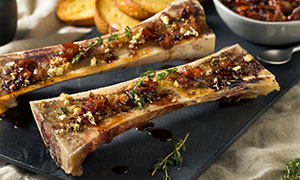
I discovered something not long ago that surprised me.
It turns out our Primal ancestors ate a lot more fat than we previously believed, and this helped their bodies and brains thrive — turning us into the species that we are today.1

Nora Gedgaudas, author of the best-selling Primal Body, Primal Mind, will be speaking at my upcoming Confidential Cures Summit.
And the majority of the fat they ate comes from what I call “the missing food group.”
Of course, you’d never hear this from traditional doctors and “diet dictocrats.” For more than 60 years, they’ve lied and told you to eat low-fat, high-carb foods.
As a result — we got slower, sicker and fatter.
But today, I feel like the message to eat more fat is finally beginning to resonate with people.
Nora Gedgaudas has been working hard to get this message out. She will be a featured speaker at my upcoming Confidential Cures Summit. She discovered the benefit of a fat-rich lifestyle in the most fascinating way.
Nora is a nutritionist and the best-selling author of “Primal Body, Primal Mind: Beyond the Paleo Diet for Total Health and A Longer Life” and “Primal Fat Burner: Live Longer, Slow Aging, Super-Power Your Brain, and Save Your Life with a High-Fat, Low-Carb Paleo Diet.” She learned the benefits of a high-fat diet while living among a family of wild wolves 500 miles from the North Pole.
Nora spent the summer on the frozen tundra in the Arctic. Her work involved spending a lot of time sitting around observing the wolf family. Every few days she made the long trek to the weather station for supplies.
Within a week or two, she says she started to crave high-fat foods. Of course, as a traditionally trained scientist, she was used to eating a low-fat diet.
Before long, she was devouring all the high-fat foods she could put in her body. It was a meal plan remarkably similar to our ancient ancestors. Not only did Nora’s health start to improve — and her life-long depression vanish — but she shed both weight and excess body fat.
It was the start of a lifestyle revolution for the researcher…
This missing food group has pretty much disappeared from our modern-day eating plan.
You see, we evolved to derive nutrients from almost every part of an animal. When your primal ancestors went hunting for a woolly mammoth or big cat, nothing they caught was wasted. They ate everything… including organ meat, skin, cartilage entrails and gristle.
All of it is extremely high in the healthy fat that helped us to develop. Today, we’re starving for this missing food group. And our health has been suffering big time because of it.
But we can regain our primal nutrition by returning to an eating plan rich in this forgotten food group. These foods are among the most nutritious foods on the planet. Some of their nutrients include:
|
•CoQ10 |
•Magnesium |
|
•Vitamins B1, B2, B6 and B12 |
•Selenium |
|
•Iron |
•Zinc |
|
•Copper |
•Vitamins A and K |
|
•Glycine |
•Glucosamine |
The most important nutrient we don’t eat today is the marrow hidden inside animal bones. This spongy tissue was prized by our ancestors. And modern science confirms what these ancient humans knew. That bone marrow is a nutritional powerhouse.
In fact, research shows that this collagen-rich food heals your gut,2 boosts immunity,3 rebuilds your joints,4 fights cancer,5 decreases inflammation6 and reduces the risk of diabetes.7
But bone marrow also contains a protein hormone called adiponectin.
This protein switches on your stem cells that develop into red blood cells, white blood cells and platelets involved in oxygen transportation, immune function. It then instructs the stem cells to travel to where they are most needed — allowing them to repair dying or diseased tissue.8
Roasted Bone Marrow with Thyme

Roasted bone marrow is a delicious meal and full of protein.
I love roasted bone marrow from bovines. It’s rich and creamy and one of the foods I grew up eating. It’s also remarkably easy to make. Here’s one of my favorite new recipes:
Ingredients:
•2 center-cut beef bones from grass-fed cow
•4 cloves garlic, minced
•3 Tbsp. unsalted butter
•2 Tbsp. chopped thyme
•2 Tbsp. chopped fresh rosemary
•2 tsp. salt
•1 tsp. pepper
Directions:
- Preheat oven to 450 degrees Fahrenheit. Place bones, cut side up, on a baking sheet lined with foil. Bake bones until marrow is soft and has begun to separate from the bone, about 7 to 10 minutes.
- Mix together garlic, thyme, salt and pepper in a bowl.
- Remove bones from oven, and generously cover with garlic mixture.
- Return bones to oven and bake for 10 minutes until no longer pink inside. You’ll want to remove the roasted bones before the marrow begins to “cook out” of the bones.
Enjoy!
To Your Good Health,

Al Sears, MD, CNS
References
1. Thompson JC, et al. “Origins of the human predatory pattern: the transition to large-animal exploitation by early hominins.” Curr Anthropol. 2019;(60)1:1-23.
2. Salvatore S, et al. “A pilot study of N-acetyl glucosamine, a nutritional substrate for glycosaminoglycan synthesis, in paediatric chronic inflammatory bowel disease.” Ailment Pharmacol Ther. 2000;14(12):1567-1579.
3. Rennard BO, et al. “Chicken soup inhibits neutrophil chemotaxis in vitro.” Chest. 2000;118(4):1150-1157.
4. Crowley DC, et al. “Safety and efficacy of undenatured type II collagen in the treatment of osteoarthritis of the knee: A clinical trial.” Int J Med Sci. 2009;6(6):312–321.
5. Profírio E and Fanaro GB. “Collagen supplementation as a complementary therapy for the prevention and treatment of osteoporosis and osteoarthritis: A systematic review.” Rev. Bras. Gerontol. 2016;19(1):153-164.
6. Rahman M, et al. “t10c12-CLA maintains higher bone mineral density during aging by modulating osteoclastogenesis and bone marrow adiposity.” J Cell Physiol. 2011;226(9):2406–2414.
7. Cawthorn WP, et al. “Bone marrow adipose tissue is an endocrine organ that contributes to increased circulating adiponectin during caloric restriction.” Cell Metab. 2014;20(2):368-375.
8. Yu L, et al. “Adiponectin regulates bone marrow mesenchymal stem cell niche through a unique signal transduction pathway: An approach for treating bone disease in diabetes.” Stem Cells. 2015;33(1):240–252.








